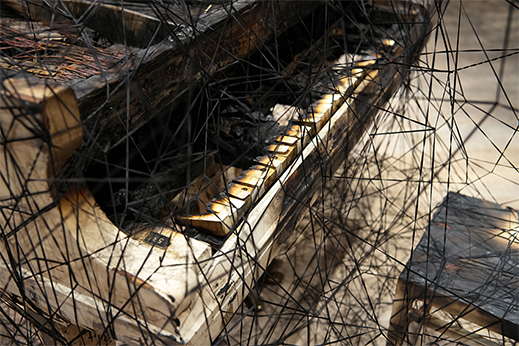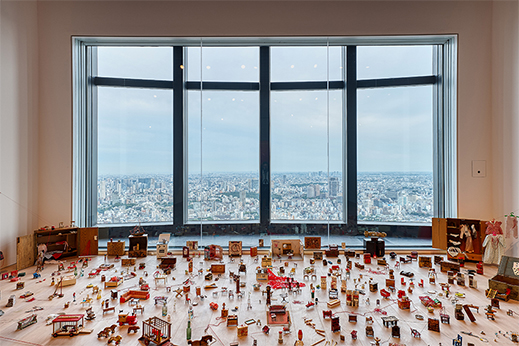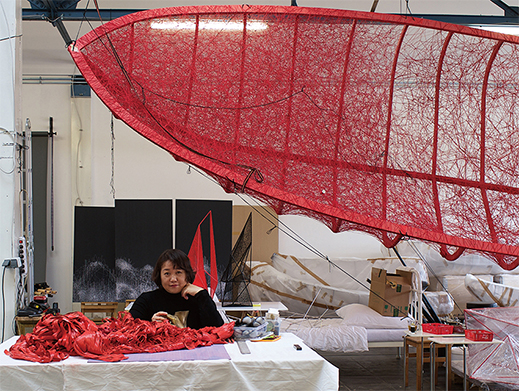 |
|
Here and There introduces art, artists, galleries and museums around Japan that non-Japanese readers and first-time visitors may find of particular interest. The writer claims no art expertise, just a subjective viewpoint acquired over many years' residence in Japan.
|
|
 |
|
|
 |
 |
String Theory: Chiharu Shiota at the Mori Art Museum
Alan Gleason |
 |
Uncertain Journey (2016/2019); metal frames, red wool. Courtesy: Blain | Southern, London/Berlin/New York. Photo: Sunhi Mang |
Artists whose installations feature vast webs of yarn or thread (and there are quite a few these days) often speak of them as symbols of interconnection, whether between the self and others, life and death, or past, present and future. But such materials trigger other associations too. When we first enter one of Chiharu Shiota's room-sized constructions of red or black thread, the material's color alone can dramatically affect our emotional response. Swathes of red readily suggest blood, or fire; black may conjure up clouds of smoke or the dark of night.
Shiota's ambitious retrospective at the Mori Art Museum, titled The Soul Trembles, includes many non-stringy works too. They run the gamut from sculptures made of bronze-cast body parts, to window frames taken from dismantled houses, to videos of solo performance pieces and major stage productions, the latter set against or amid her designs. However, it is the big installations utilizing thread or rope that stand out, and that have probably contributed the most to Shiota's current visibility on the global art scene.
Out of My Body (2019); cowhide leather, bronze. Photo: Sunhi Mang |
The first gallery one enters at the Mori is the most dramatic: great billows of scarlet woolen yarn rise and spread across the ceiling from a number of black metal boat-shaped frames scattered around the floor. In another room, rows of burnt wooden chairs and a solitary charred grand piano are tangled in a mass of black thread. In the first instance one cannot help but think of gushers of blood hemorrhaging from the boats; in the second the black net resembles a grim pall of smoke hanging in the air after a conflagration. Another installation fills an entire gallery with a cascade of suitcases suspended from the ceiling on red ropes; a network of pulleys jiggles them up and down, so that the tumbling luggage seems to bob on waves as it flows from -- what? a sinking ship? Other viewers will doubtless take away other associations, but I think many of us are likely to find something ominous in these images, if not downright sanguinary.
 |
|
 |
|
In Silence (2002/2019), with detail of the piano; burnt piano, burnt chairs, Alcantara black thread. Production support: Alcantara S.p.A. Courtesy: Kenji Taki Gallery, Nagoya/Tokyo. Photo: Sunhi Mang |
When I began to read the artist's own descriptions of her work, however, I was struck by the disparity between them and these first impressions. Certainly there are strong undercurrents of pain and uncertainty in Shiota's worldview. In her words: "Helpless conflicts of minds, uncommunicable emotions and my inexplicable existence; these feelings give all my works form and shape." At the same time, she takes pains to describe the networks of thread in her work as symbols of connection, relationship, and wonderment. From the museum website: "Spectators walking through these spaces strung with thread are made aware, experientially and visually, of the intangible: invisible connections, memories, unease, dreams, and silence. Regarding the color of the thread, Shiota has said that the black can be interpreted as the night sky or cosmos, and the red as blood, or alternatively, the 'red thread of fate' that in East Asian belief binds people together." The boats and suitcases hint at "memories, movement, and migration," while the fire-ravaged piano implies "silence."
 |
|
Accumulation - Searching for the Destination (2014/2019); suitcases, motors, red ropes. Courtesy: Galerie Templon, Paris/Brussels. Photo: Kioku Keizo |
The show's curators have accompanied the exhibits with quotes from the artist herself, an edifying arrangement but one that challenged my aversion to reading an artist's words about a work before viewing it, or even afterward. I used to be an ardent reader of such texts until an artist friend recommended simply heading for the works that catch your eye and contemplating them without preconceptions -- no checking the title or any other explanatory gloss. I took this advice to heart, though I don't always remember to follow it. Naturally enough, those initial impressions may be at odds with the artist's expressed intentions. Maybe that's why I'm partial to artists who don't try to explain too much.
Inside - Outside (2008/2019); old wooden windows. Courtesy: Kenji Taki Gallery, Nagoya/Tokyo. Photo: Sunhi Mang |
There is a current in Japanese art criticism that accepts the ineffable in art as just that. Western critics often appear driven to analyze and theorize, even about work that an artist may have created without any articulable concepts in mind. Artists, too, are expected to find the words and the theory to explain their output. In Japan, there seems to be greater tolerance for the inarticulate artist -- and, for better or worse, even the inarticulate critic.
Judging by the extensive texts that accompany the Mori show, Shiota is quite forthcoming in her willingness to discuss the thoughts behind her art. I wondered, idly, if that impulse derived in part from her experience living and working in the West -- Berlin, to be exact -- for the past 25 years. Granted, an artist's explanations reveal facets of their work that viewers might otherwise overlook and misinterpret. Yet our first impressions also reveal truths worthy of our attention -- about our own state of mind, certainly, if not the artist's.
 |
|
Connecting Small Memories (2019); mixed media. Photo: Sunhi Mang |
A little knowledge of an artist's personal history can also carry inordinate weight in our response to their work. Shiota writes frankly of her personal trials, which include miscarriage and a recent recurrence of cancer. Knowing this backstory, I found myself projecting notions of mortality, anxiety and loss onto works that the artist clearly intends to evoke a broader range of emotions, including hope and courage.
There is undeniably something vital and life-affirming about Shiota's installations. One senses a common emotional ground between these monumental works and her earlier performance-art videos, one of which depicts endless streams of mud pouring over her naked body. Clearly life, and the living of it, are a warts-and-all proposition for Shiota, as for all of us, and she has found compelling ways to articulate that irreducible truth and look it squarely in the eye.
Stage design of the Noh-based opera Matsukaze, Theatre Royal de la Monnaie, Brussels (2011). Photo: Sunhi Mang |
Just as intriguing as the string installations are a series of videos showing opera performances staged amid Shiota's sets, which often feature the same all-enveloping threadwork, as well as mazes of clear plastic tubing through which a red liquid courses. The actors (and in some productions, members of the audience) move among these props, which simultaneously hinder and accentuate their movements. Indeed, Shiota's installations may work best when put to use as stage sets. By themselves they are stunning to look at, but they really come to life when people interact with them.
Therein lies another dilemma. I couldn't help hankering for a chance to see Shiota's big string creations in solitude -- preferably an empty room, as they appear in these press photos. Crowds, particularly in the numbers drawn to this popular show, can be distracting. As Tokyo museumgoers know better than anyone, it's hard to maintain a state of mind conducive to absorbing the full impact of a work when the gallery resembles a train during rush hour. The stage productions, however, offer hints for attitude adjustment: perhaps we are meant to treat our fellow visitors as part of the installation -- the "others" to whom we are inextricably bound in the dense web of human relations as well as in our shared fate. Shiota's art makes us ponder not only the power that memories, relationships, and death carry in our lives, but also the inherent contradictions of trying to give physical form to those forces within the confines of a museum.
 |
|
Chiharu Shiota. Photo: Sunhi Mang |
All works shown are by Chiharu Shiota. All images are courtesy of the Mori Art Museum. |
 |
| Shiota Chiharu: The Soul Trembles |
| 20 June - 27 October 2019 |
| Mori Art Museum |
53F, Roppongi Hills Mori Tower
6-10-1 Roppongi, Minato-ku, Tokyo
Phone: 03-5777-8600 (Hello Dial)
Hours: 10 a.m. to 10 p.m. (to 5 p.m. Tuesdays); admission until 30 minutes before closing. Closed when no exhibitions are being held.
Transportation: Direct access from Exit 1C, Roppongi Station (Tokyo Metro Hibiya Line or Toei Oedo Line); 10 minutes' walk from Azabu-Juban Station (Tokyo Metro Namboku Line or Toei Oedo Line) and Nogizaka Station (Tokyo Metro Chiyoda Line)
|
|
|
|
| |
 |
Alan Gleason
Alan Gleason is a translator, editor and writer based in Tokyo, where he has lived for over 30 years. In addition to writing about the Japanese art scene he has edited and translated works on Japanese theater (from kabuki to the avant-garde) and music (both traditional and contemporary). |
|
|
|
|
|
|
|
|
|
 |
|